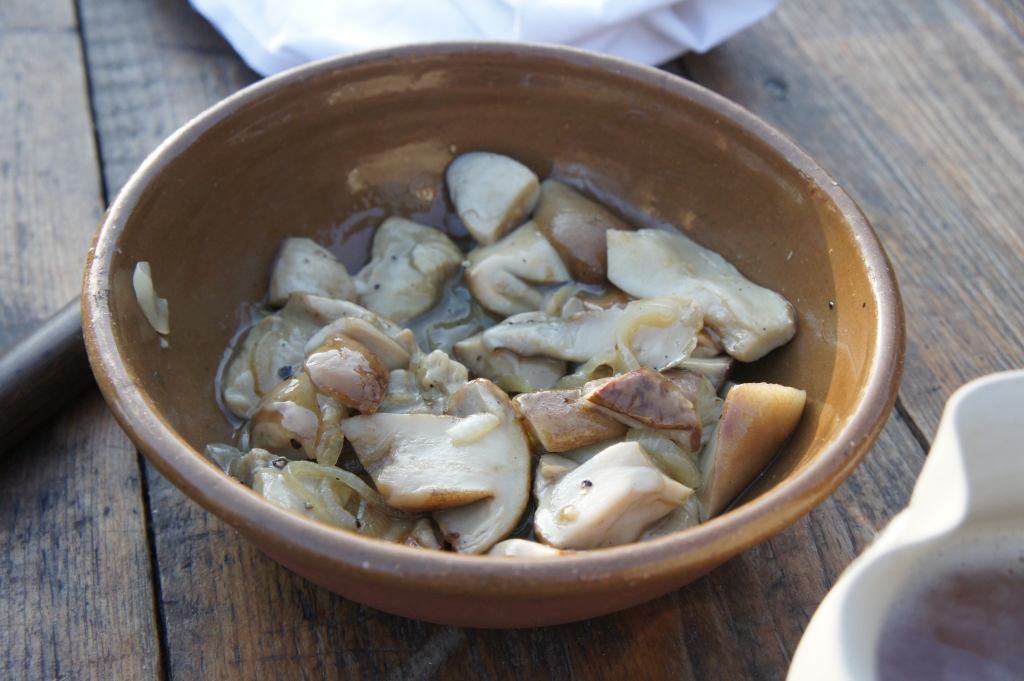42. — De fungo montano : fungum montanum ad lixandum pone.
Eiecta aqua, postea pone ad frigendum cum cipola incisa minutim uel
alto porro et speciebus et sale.
Quelle English
Leider hab ich dafür keine freie Übersetzung gefunden, da ich aber selber auf eine Übersetzung angewiesen bin, nutze ich die Ausgabe von Robert Maier (Hrsg.), Liber de Coquina, Frankfurt, 2005. Bei Maier hat das Rezept die Nummer 7.12, da die Rezepte der beiden Teile (Tractatus und Liber de Coquina) in der Ausgabe fortlaufend gezählt werden.
So haben wir es gekocht:
- Die Pilze putzen und in große Stücke schneiden
- Ganz leicht gesalzenes Wasser zum kochen bringen und die Pilze kurz hineingeben
- Zwiebel fein auf scheiden und mit etwas Butter oder Öl in der Pfanne andünsten
- Mit einem Seihtuch die Pilze abgießen
- Die Pilze in die Pfanne zu den Zwiebeln geben und kurz mit andünsten.
- Im Rezept werden noch Gewürze zugegeben. Wir haben uns auf Salz, Pfeffer und ein klein bischen Honig beschränkt
Zutaten:
Steinpilze (rein spekulativ: Italien, Berg, Pilze -> Steinpilz. Und von allen ausprobierten Sorten bis jetzt die leckerste Variante), Zwiebel, Salz, Pfeffer, Honig
Küchengerätschaften:
Pfanne, Topf, Messer, Seihtuch
|LC-1.42| Mountain mushrooms
That’s how we cooked it:
- Clean the mushrooms and cut them into large pieces
- Bring lightly salted water to the boil and add the mushrooms for a short while
- Chop the onion finely and sauté with a little butter or oil in a pan
- Drain the mushrooms with a cheesecloth
- Put the mushrooms in the pan with the onions and sauté briefly
- Spices are added in the recipe. We have limited ourselves to salt, pepper and a little honey.
Ingredients:
Porcini mushrooms (purely speculative: Italy, mountain, mushrooms -> porcini mushrooms. And of all the varieties tried so far, they are the tastiest variety), onion, salt, pepper, honey.
Kitchen utensils:
pan, pot, knife, cheesecloth
Quelle des von uns verwendeten Rezepttextes:
Liber de coquina ubi diuersitates ciborum docentur (saec. XIV.), ed. Mulon, Marianne
aus der Sammlung Monumenta Culinaria et Diaetetica Historica
Datei-Info der Gesamtdatei:
Liber de coquina ubi diuersitates ciborum docentur (saec. XIV.)
— Text based upon: Mulon, Marianne: Deux traités inédits d’art culinaire médiéval. In: Bulletin philologique et historique (jusqu’à 1610) du Comité des Travaux historiques et scientifiques. Année 1968: Actes du 93e Congrès national des Sociétés savantes tenu à Tours. Volume I: Les problèmes de l’alimentation. Paris 1971, 369-435; the text of the Liber de coquina on p. 396-420.
— Digital version: Thomas Gloning, 9/2002
<> etc. = page numbers of the Mulon edition; — I changed some spaces before or after certain punctuation marks (e.g. “. 4.” to ” .4.”). — I kept the linebreaks of the edition, but removed hyphenation in order to facilitate the search for word forms. — For the introduction, the apparatus and all editorial matter, please see the printed Mulon version. Cf. also: Bruno Laurioux: Le règne de Taillevent. Paris 1997, passim (see index, p. 417 s.v. Liber de coquina). — Certain places in the text are puzzling to me, e.g. II-20 “… et ponatur in spico ad inssandum”; it seems to me that such places would have deserved some editorial commentary: be it emendation, be it explanation that these forms are o.k. for, say, some region of 14th century Italy, or be it only confirmation that this is simply what the scribe(s) wrote.
— (c) You may use this digital version for scholarly, private and not-profit purposes only. Make sure that you do not violate copyright laws of your country. Do not remove the header from this file.

